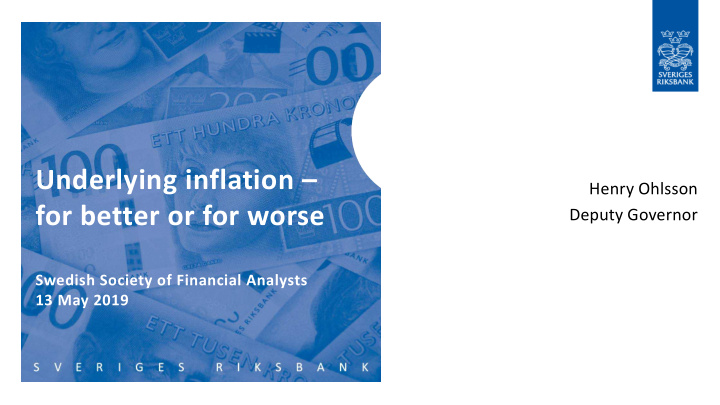



Underlying inflation – Henry Ohlsson for better or for worse Deputy Governor Swedish Society of Financial Analysts 13 May 2019
CPIF inflation – the monetary policy objective 3 3 2 2 1 1 0 0 -1 -1 11 13 15 17 19 Note. The CPIF, annual percentage change. Source: Statistics Sweden
Questions • Why differentiate between lasting and temporary price movements? • When was the concept of underlying inflation first used? • What to do? Two different approaches! • What are the desirable properties? • Which consumer prices should be excluded? • What have we learnt?
Why differentiate between lasting and temporary price movements? • Objective of monetary policy • The concept of inflation • Key words: “Prices in general” “lasting” • Central banks’ use of the concepts core inflation and underlying inflation
When was the concept of underlying inflation first used? • Sporadically mentioned in academic research • Text analysis: Schreder (1952) • Began to be used more regularly as inflation rose quickly in 1973 and 1974 Friedman (1974) • Bureau of Labor Statistics (BLS) began calculating the measure in 1978
CPI inflation in the USA Annual percentage change Source: Bureau of Labor Statistics
What to do? Two main approaches • Statistical methods to exclude, or dampen, the effect of temporary price changes over time • The other common approach is to exclude predetermined goods and services
Statistical methods: Separating trend from white noise 3 3 2 2 1 1 0 0 -1 -1 11 12 13 14 15 16 17 18 19 Note. The CPIF, annual percentage change. Source: Statistics Sweden
Statistical methods: Separating trend from white noise 3 3 2 2 1 1 0 0 -1 -1 11 12 13 14 15 16 17 18 19 Note. The CPIF, annual percentage change, 12-month moving average. Sources: Statistics Sweden and the Riksbank
Exclusion: CPIF inflation and energy prices Annual percentage change 4.0 105.1 3.5 104.9 3.0 104.7 2.5 104.5 2.0 104.3 1.5 104.1 1.0 103.8 0.5 103.6 0.0 103.4 -0.5 103.2 -1.0 103.0 06 07 08 09 10 11 12 13 14 15 16 17 18 19 CPIF / CPIF excluding energy (index = 100 year 2000), right Contributions to CPIF, oil-related products Contribution to CPIF, electricity Sources: Statistics Sweden and the Riksbank
Desirable properties • Should have the same average as the actual rate of inflation. • Covary with the trend in actual inflation and should have lower volatility • Should say something about the future actual inflation rate • Should covary with factors that are important to the development of the actual inflation rate • The measure of underlying inflation should be easy to understand
Best in test: Principal component analysis Annual percentage change 3.0 2.5 2.0 1.5 1.0 0.5 0.0 -0.5 11 12 13 14 15 16 17 18 19 CPIFPC CPIF Sources: Statistics Sweden and the Riksbank
Which consumer prices should be excluded? Components of the CPIF with the highest volatility 1995-2019
Components of the CPIF with the lowest volatility 1995-2019
Prices with high and low volatility respectively in the CPIF Annual percentage change 12 10 8 6 4 2 0 -2 -4 -6 95 00 05 10 15 Prices with high volatility (weight about 17 percent) Prices with low volatility (weight about 38 percent) Other prices (weight about 45 percent) Sources: Statistics Sweden and the Riksbank
Underlying measures and monetary policy The first conclusions: • There are measures that are better or worse with regard to fulfilling the criteria for important properties. • There is no measure that is unequivocally better than all the others. • The measure that is systematically better than other measures; some are great in many respects, others terrible in many respects.
Underlying measures and monetary policy • Problems for responsible monetary policy decision-makers: • Need to approach existing data with caution and to regard them from different perspectives • But at the same time, need to be clear and transparent with regard to the objective for monetary policy • The conflict becomes particularly clear if one chooses to use measures of underlying inflation that systematically deviate from the actual rate of inflation.
Underlying measures and monetary policy Handelsbanken Capital Markets, June 2018: “The Riksbank's focus on CPIFXE in connection with the April meeting resulted in questions on whether the Riksbank was changing target variable or rudder once again. This is not the case.” Nyhetsbyrån Direkt, September 2018: “CPIFXE inflation (the CPIF excluding energy), the measure on which the Riksbank is currently focusing a lot, …”
What have we learnt? • There are different types of decomposition of the development of inflation, but they give no essential explanations for it. • Inflation is the result of a very large number of economic agents’ individual decisions to change prices.
Recommend
More recommend